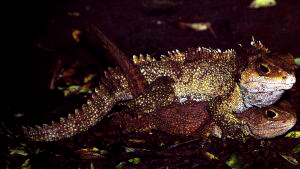
(Sphenodon punctatus)


This technique works well for burrows where insects and the occasional stray bird or lizard may end up, but adults also actively forage for eggs and chicks.
Tuataras are night hunters and probably sneak up on unsuspecting sea birds while they are sleeping. They can withstand very low temperatures and are able to tolerate temps as low as 70C (450F).
Young individuals are more active than adults and prefer the day time. They are more the foraging type when it comes to food. Their wary and speedy nature also make them hard to observe.
If he, instead, attracts the unwanted attention of a male, then a territorial battle ensue. The male will first increase his size by laterally compressing his trunk while inflating his neck and elevating his crests. The males stand about 1 meter apart from one another with their heads facing away from each other and mouths agape. Then each male will begin snapping his mouth shut in an attempt to frighten off the rival. If this does not work then a fight will ensue.
Lizards are spunky fighters when pressed and tuataras, being their close relatives, seem to be as well. In a fight, the males will lock their jaws onto each other and begin scuffling on the ground. Dirt and leaves will be thrown up, the males will emit croaking sounds and the two may even flip each other over in the process. Only after one male gives up does the fight stop. And it takes a lot for a male to give up. Broken or missing toes, jaws and tails are not uncommon.
Eventually a female gets enticed by a male. At which point the male will begin slowly circling her using a stiff legged walk. He may do this for 20 minutes or more. He will only stop when the female either lets him mount her or rushes down a burrow.

After the initial mating the female will hold off until spring at which point her and many other females will get together at communal nesting sites in the sunnier portions of the islands. She will then dig several trial holes until she is satisfied with the right one. After her approval of her hole, she will then lay her clutch of up to 19 soft shelled eggs (although 7-10 is more normal). Several more nights are spent filling and then guarding the hole where the eggs are. Only after every female has laid will she leave.
She won't mate again for four more years.
Tuataras have the longest incubation cycle of any reptile 12-15 months of incubation time. This is partly due to the egg's shutting down during the colder months.

They are one of the slowest growing reptiles and are believed to attain ages of 70+ years. This is equal to the lifespans of 3-4 lizards of similar size combined.